Interim braking standards set for existing vehicles
Page 41

If you've noticed an error in this article please click here to report it so we can fix it.
All types to reach same efficiencies by 1972 THE Ministry of Transport this week circulated to interested bodies the braking standards which it intends to apply to existing goods vehicles over 30 cwt. unladen. These will permit existing unplated heavy vehicles to conform to a slightly lower standard than 'that set for plated models in the 1964 amendments (SI. 1169) to the C. and U. Regulations and those circulated last September for application to all new heavy goods vehicles.
The Ministry's working party on brakes has recommended that, by 1972 at the latest, the braking efficiencies required of existing and new vehicles should be the same (that is, a minimum of 50 per cent and 25 per cent for service and emergency brakes respectively). But it has been recognized that meanwhile it will be necessary to permit lower standards to apply to existing vehicles and the Minister, recognizing that these older vehicles "represent an important economic asset to the community" has accepted the working party's advice on this matter.
The result is that, when the new regulations come into force, existing two-axled rigid vehicles will have to achieve efficiencies of 45 per cent and 20 per cent for service and emergency brakes respectively, while multiaxled rigid vehicles, articulated vehicles and vehicle-and-trailer combinations will only need to achieve 40 per cent and 15 per cent for service and emergency systems respectively.
The intention to introduce these minima
for existing unplated vehicles at the same time as the proposed regulations circulated last September for new vehicles would have meant a target starting date of January 1, 1967, but this week the Ministry revealed that because of "technical and manufacturing difficulties" it is unlikely that this starting date will be achieved.
In drafting the new regulations for existing vehicles, the Ministry has added one new definition under Regulation 3(1), reading as follows: "'Rigid vehicle' means a motor vehicle which is not so constructed that a trailer may by partial superimposition be attached thereto in such a manner as to cause a substantial part of the weight of the trailer to be borne thereby".
The Ministry has asked interested bodies to comment on the regulations by May 31.








































































































































